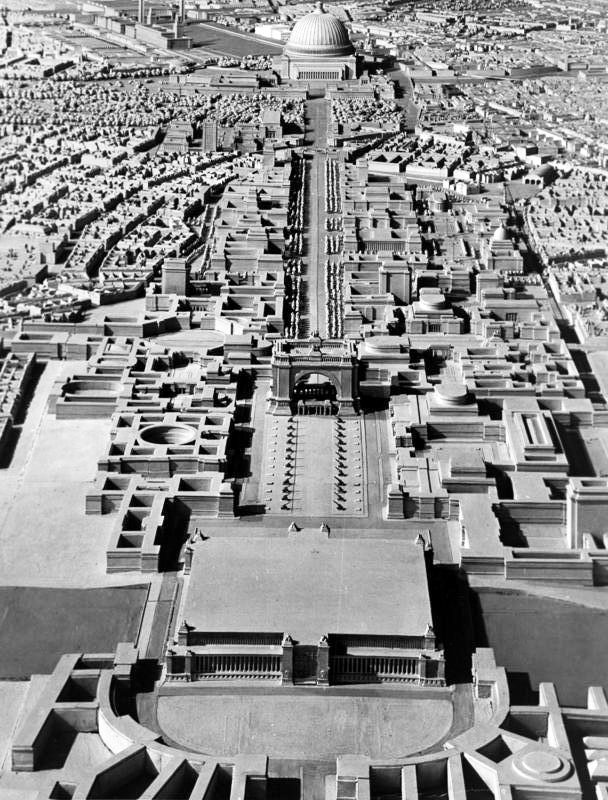From the iconic Brandenburg Gate to the tranquility of the Tiergarten, modern-day Berlin is certainly not short of attractions. Germany’s capital is also peppered with clues to a tumultuous and sometimes troubled past. During one of its darkest episodes, as the Nazis rose to power and the world hurtled towards global conflict once more, Adolf Hitler was drawing up plans to turn this city into a mega-capital worthy of his vision for a Germanic new world order.
Hitler’s vision
Historians have suggested that Hitler’s dreams for Berlin went back far further than his political ascendence. There are mentions of rebuilding Germany in his book, Mein Kampf, which he started writing in 1924 while in prison for his role in an attempted insurrection against the Weimar Republic.
However, the concept of transforming Berlin into a megacity really got going in 1936, when the then Chancellor of Germany began discussions with architect Albert Speer. Speer was ambitious and an enthusiastic supporter of the Nazi party, and quickly caught Hitler’s attention. He was charged with the design of key events like the Nuremberg Rallies, as well as the Chancellor’s more aspirational building projects.
A city to rival all others
Hitler envisaged a new Berlin, a megacity that drew inspiration from all of the most impressive buildings and monuments in Europe. Hitler and Speer essentially planned to supersize them, with the pièce de résistance being a 99,000-square-meter (1,065,627-square-foot) Grand Hall, based on the dome of St Peter’s Basilica in Vatican City and the Pantheon in Rome.
Viewers of the TV adaptation of Philip K. Dick’s The Man in the High Castle will have an idea of the scale of the redevelopment that they were planning, but this original model also demonstrates how the new capital might have looked.
The reimagined Berlin would have been centered around the Grand Hall, and the broad avenue leading to it from the planned Triumphal Arch.
It’s commonly believed that Hitler named his fantastical city Welthauptstadt Germania – “World Capital” Germania. However, historian Gerlot Schaulinski explained to the Guardian that this is actually a misconception: “The name only emerged after the publication of Speer’s 1969 memoirs, Inside the Third Reich, and is actually based on casual remarks made, we believe, just twice by Hitler in conversation with a close circle of acquaintances.”
Whether or not the Führer was prepared to give the project such a grandiose name, it’s clear from the surviving models that there was little limit to his ambition.
Speer’s plans also left no room for consideration of the needs of the citizens of Berlin. The emphasis was on theater and grandeur, not livability. Thousands were displaced to make way for building projects – for a city that, remember, never actually ended up being built – and tens of thousands of residential homes would have been laid to waste to make room for gargantuan new structures.
Even the wide avenues, like the Strasse des 17. Juni which runs from the Brandenburg Gate west through the Tiergarten, would have been a no-go zone for pedestrians, who would have been forced to give way to motor traffic and instead traverse the city underground.
The Strasse des 17. Juni, looking towards the Victory Column. This monument was moved from its original position, and the base was modified to raise it higher at Hitler’s insistence.
Image credit: Phillip Kraskoff/Shutterstock.com
There’s a darker side to all this building fever: The construction of Germania is inextricably linked to the Holocaust and the horror of the concentration camps.
Prisoners of the camps – as well as prisoners of war, beggars, Roma, and homosexuals – rounded up on the streets of Berlin were used as slave labor to provide building materials. Jewish Berliners were evicted from their homes to make way for the proposed construction works, even before the Nazis began to target this community directly for removal to the ghettos and, eventually, the concentration camps.
When Albert Speer was eventually convicted of war crimes at the Nuremberg Trials in the immediate aftermath of World War Two, he still denied any knowledge of the planned genocide of Jewish people.
The legacy of Germania
While very little of the plans for Germania were ever realized, there is a legacy of the construction project that visitors can still see today. The Schwerbelastungskörper is a massive concrete cylinder, weighing a whopping 12,650 tonnes, which was built to test whether the swampy soil of Berlin would be able to hold the weight of the planned Triumphal Arch that would serve as a monument to Germany’s First World War casualties.
The Schwerbelastungskörper stands 14 meters (46 feet) above the ground, but it’s sunk so much that 18 meters (59 feet) of it are now submerged.
The experiment with the cylinder actually showed that the arch would have come a cropper, were it ever built – the soil in the area simply could not sustain such a structure. However, it’s not clear whether that would actually have dissuaded a megalomaniac Chancellor in the grip of a building frenzy.
This is, after all, a man who famously said, “Berlin will be comparable as a world capital only to Egypt, Babylon or Rome.”
Source Link: Germania: Hitler’s Dream For His Third Reich Capital Megacity
